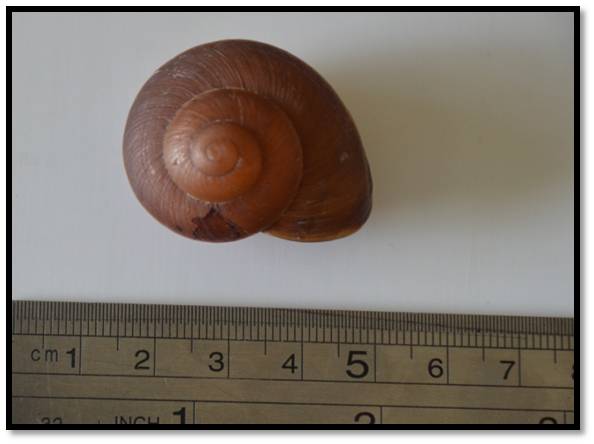
Micro mollusks that can grow up to 0.5 mm were discovered in the forests of Argao town, southern Cebu.
As the rainy season takes over the country, snails become a common garden “pest.”
But the small creatures others would consider a nuisance, actually play a much bigger role in the ecosystem than many people give them credit for.
“Snails serve as a nutrient recycler, breaking down leaves and other plant materials and bringing back their nutrients into the soil,” said Professor Rama Rosales, Vice President for Research and Development of Cebu Technological University (CTU).
Rosales heads an ongoing research to identify snail species in Cebu as part of the Niche Center for Terrestrial Biodiversity (NICER) program of the Department of Science and Technology (DOST)-Philippine Council for Agriculture, Aquatic, and Natural Resources Research and Development (PCAARRD).
The research has led Rosales’ team to discover a unique snail species in Argao town, southern Cebu, which might turn out to be the smallest in the world.
The snail, which grows up to only 0.5 mm and hides under litters of leaves, could barely be seen by the naked eye.
He said that the yet unidentified tiny snail species provided a new perspective on the biodiversity of Cebu forests.
“We don’t (usually) see them but they indicate that our forests are alive. We don’t know how long they have been there because nobody could see them,” said Rosales.
Rosales added that researchers are awaiting the arrival of a more powerful microscope next year that will make the identification and classification of the newly discovered micro mollusks in Argao easier.
The current world record for the smallest snail is held by Guangxi, China.
The world’s smallest snail, identified as the Angustopila dominikae, grows to at most 0.86 mm.
The unidentified micro mollusks in Argao is smaller than the Angustopila dominikae.
“It would be a great discovery if our micro mollusks in Argao would be proven to be the smallest snail in the world,” said Rosales.
Rosales said that it would take time before the Argao micro snails can claim to be the smallest in the world since the research team still has to continue the study on the snails’ life cycle and morphology.
DOST-PCAARRD allotted P18M for the NICER projects in Central Visayas to encourage researchers to study the flora and fauna of the islands to be able to identify more species and learn about their roles in preserving biodiversity.
Aside from the types of mollusks, which include snails, NICER also aims to identify species of bats, birds, ferns, and trees.
Biodiversity
Rosales said that in Cebu, with at least 20% of the landmass consisting of forest patches, biodiversity remains strong.
Rosales said that one of the most diverse animal resources in Cebu are the mollusks with at least 50-100 species that abound in different areas of the province.
Mollusks are invertebrates, found both in the sea and on land, with a soft unsegmented body covered with calcerous shell. The most common mollusks are snails.
CTU-Argao has identified over 23 species of the bigger land snails; while 17 species of micro mollusks have yet to be identified by Rosales’ research team.
They also collected the specimen of eight unidentified species of land snails.
In CTU-Argao, four plots of 20×100 forest lands are protected for the research on micro mollusks.
“At this point, all we know is that these small snails eat dead leaves. Other than that, we will need more time to study,” said Rosales.
The key to the further study of the species would be the morphological and genetic identification of the snails, which Rosales said, will need the collaborative work of many researchers.
He encouraged researchers from other institutions to help in the study of the micro mollusks since there are no published literature in the Philippines about it.
“The more researchers work on this project, the more we can understand these special species that were hidden from our eyesight on the forest floors,” he said.
Studying micro mollusks, added Rosales, can provide a “huge” potential in different fields, primarily agriculture, as they may be used to rehabilitate farmlands as biodegraders.
Rosales said they can even be used in pharmacology for the antibacterial properties present in their slime.
“There are endless possibilities as we continue to gain more knowledge about these small snails,” he said.
The micro mollusks may be too small to notice; but they provide a big role in the ecosystem that keeps the cycle of life in the forest moving gently through time.
“We need to know what lives in our forest so we can start to protect it,” said Rosales.
Aside from the research on flora and fauna, NICER projects aim to spread awareness on the lives that thrive within the forests.
Rosales expressed hopes that with Cebu’s reforestation, people will understand that some of their properties will have to be given up to provide more room for nature to grow.
“The forests in Cebu are patches so every patch holds different species of animals. We hope to one day bring together these patches into one Cebu forest. In this way, our nature can fully propagate,” he said.
Disclaimer: The comments uploaded on this site do not necessarily represent or reflect the views of management and owner of Cebudailynews. We reserve the right to exclude comments that we deem to be inconsistent with our editorial standards.
